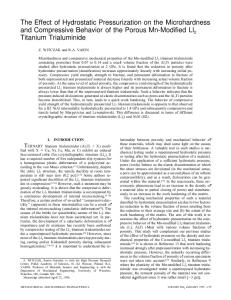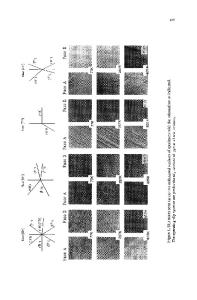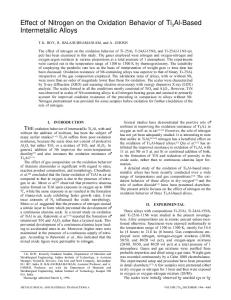The effects of hydrostatic pressure on the compressive mechanical behavior of L1 2 Al 3 Ti-based intermetallic
- PDF / 1,118,634 Bytes
- 9 Pages / 598 x 778 pts Page_size
- 26 Downloads / 346 Views
I.
INTRODUCTION
E A R L Y investigations of the mechanical properties of crystalline solids under triaxial state of stresses (hydrostatic pressure) were attributed to Voigt in 1893 who studied sodium chloride crystals and found that their breaking strength was not affected by hydrostatic pressures up to about 60 kg/cm 2. Generally, the principal effect of hydrostatic pressure on the fracture behavior of brittle materials is to raise the stress at which cracks will propagate. [1] A dramatic increase in the ductility of some metals has been obtained under hydrostatic pressure. Investigations of the behavior of brittle materials under hydrostatic pressure facilitate the explanation of the fracture mechanism in these materials because of the lack of necking occurring during testing, m With regard to the ordered intermetallic compounds, early studies of the effect of hydrostatic pressure on compressive behavior were carried out by Martynov e t al. t31 on less-common compounds such as A13Mg,, PbTe, Bi2Te3-BizSe3, V3Ga, Co2Si-CoSi, V3Si, and LaBr. Several interesting conclusions drawn by Martynov e t al. are as follows: (a) compressive ductility of investigated intermetallic compounds at room temperature increased with increasing hydrostatic pressure, and at a certain level, it could approach ductility of regular metallic materials tested under normal conditions; (b) the harder the intermetallic the lower the ductility was achieved under hydrostatic pressure; and (c) work hardening was observed to occur after compressive deformation under hydrostatic pressure. More recently, there has been research carried on the effect of hydrostatic M.B. WINNICKA, Ph.D. Candidate, and R.A. VARIN, Professor of Materials Science and Engineering, are with the Department of Mechanical Engineering, University of Waterloo, Waterloo, ON, Canada, N2L 3GI. Z. WITCZAK, Senior Scientist, is with the High Pressure Research Center, Polish Academy of Sciences, 01-142 Warsaw, Poland. Manuscript submitted April 28, 1993. METALLURGICAL AND MATERIALS TRANSACTIONS A
,pressure on the mechanical behavior of face-centered cubic (fcc) ordered (L12) Ni3AI compound[41 and body-centered cubic (bcc) ordered (B2) NiA1. t5'6'7l In both cases, an increase in tensile ductility was observed under hydrostatic pressure. The purpose of this work is to examine the effects of a superimposed hydrostatic pressure on the compressive behavior of cubic (L12) Mn-modified Ti trialuminide. In particular, the effect of superimposed hydrostatic pressure on yielding, flow behavior, microcracking, and compressive ductility were investigated. This work represents a continuation of studies on microstructure and compressive behavior of various modifications of Ti trialuminides,~8.9~
II.
EXPERIMENTAL PROCEDURE
The Mn-modified L12 A13Ti-base alloy was induction melted according to the procedure described in Reference 8. Homogenized (1050 ~ hours) material was used for mechanical testing in compression under hydrostatic pressure. Its composition, measured by a quantitative X-ray energ
Data Loading...











